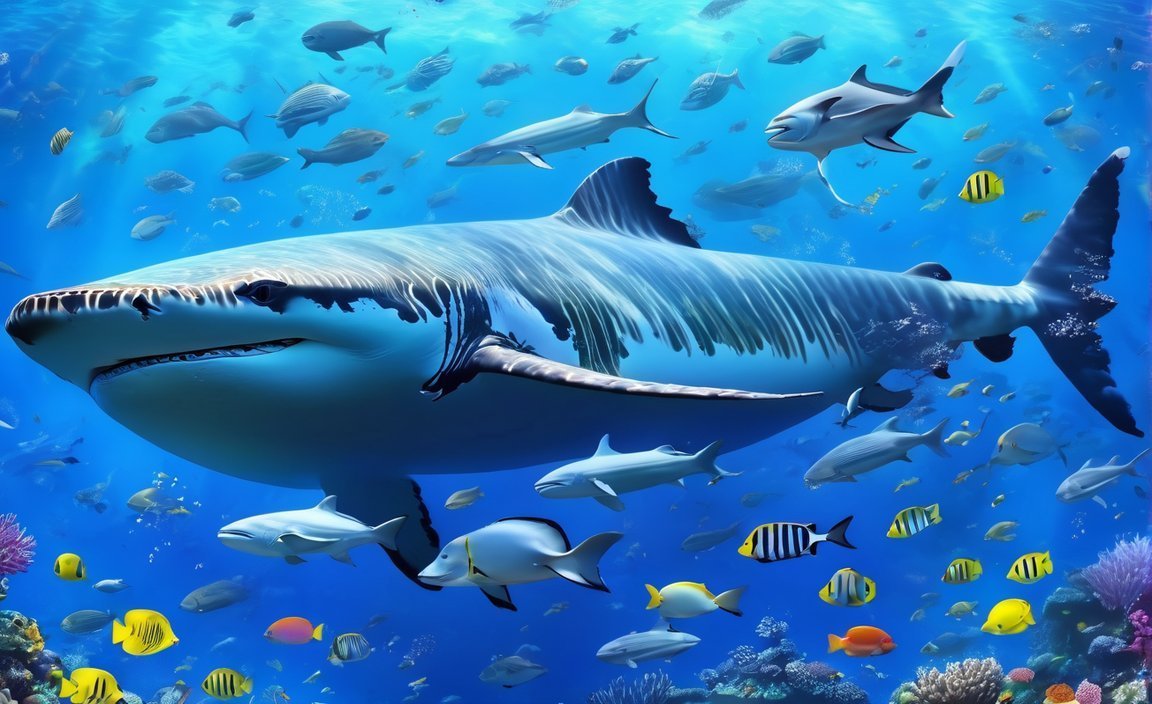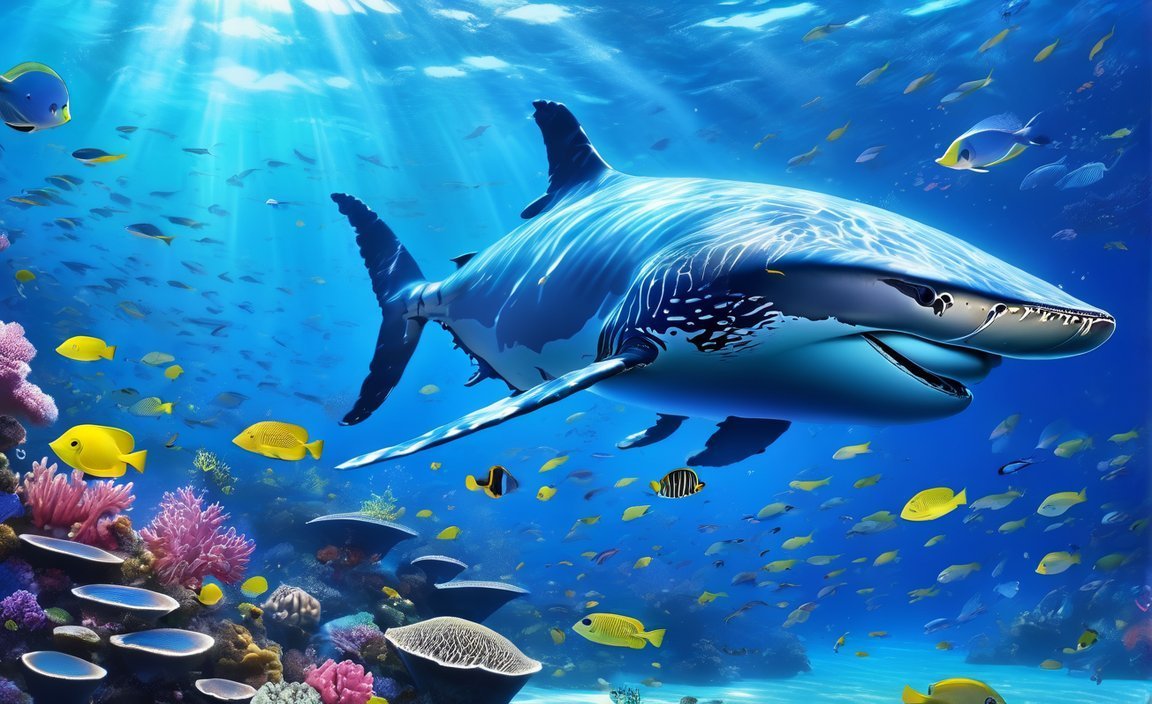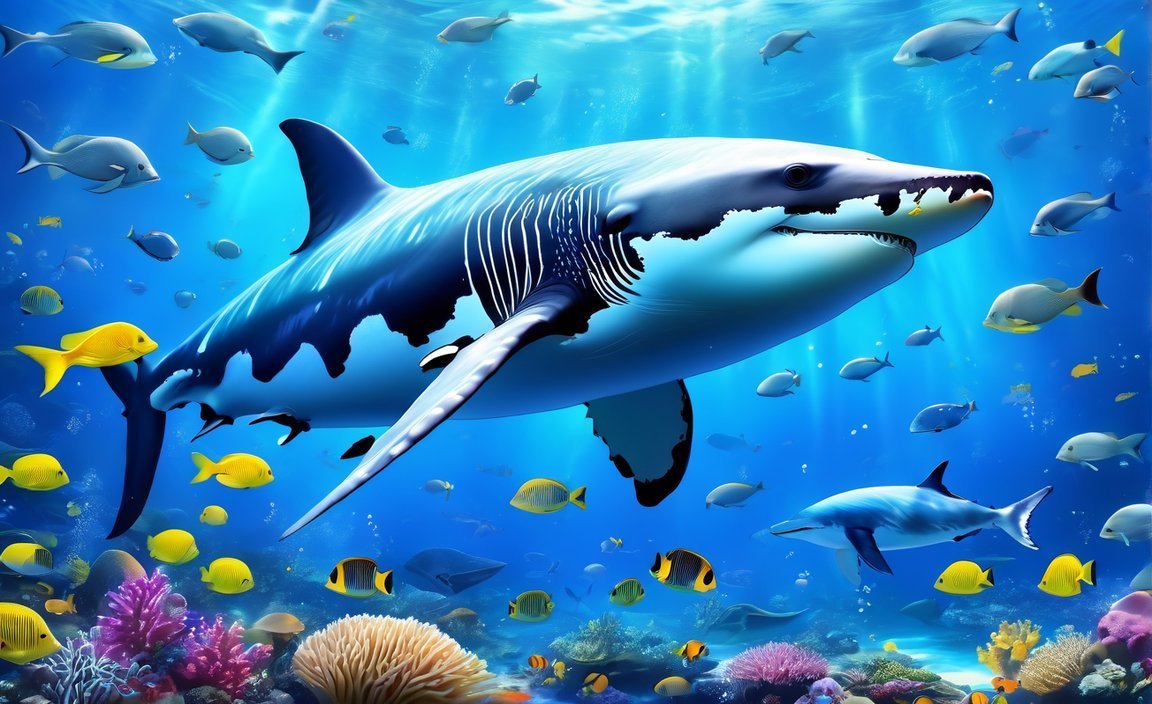Discover an enchanting underwater world as we dive into the realm of marine animals. In this article, we will uncover 10 intriguing and overlooked facts about these remarkable creatures. From the astonishing adaptations of deep-sea dwellers to the fascinating behaviors of coastal inhabitants, prepare to be amazed by the diversity and wonders of marine life. Join us as we delve into the depths of the ocean and shed light on the lesser-known aspects of these captivating animals, highlighting the importance of conserving their fragile habitats.

Key Takeaways:
- The calls of blue whales are the loudest sound made by any animal on the planet.
- Oysters can change their gender depending on what is best for mating.
- Seahorses are the only animals where the males give birth and care for their young.
- Shrimp have their heart in their head.
- Sea cucumbers act as the ocean’s vacuum cleaner.
- Stonefish are one of the most dangerous sea animals.
- Dolphins enjoy getting high.
- Coral reefs contain one-fourth of the world’s marine species.
- Approximately 2% of all bony fish are hermaphrodites.
- Mudskippers are the most land-adapted of fishes.
- Sharks have the ability to swim forever.
- Sea otters have a secret pocket near their armpits to store food.
- Beluga whales have a unique language of chirps and squeaks, earning them the nickname “canaries of the sea”.
- Male penguins “propose” to their females with pebbles during mating season.
10 Facts About Marine Animals
Marine animals have always intrigued scientists and nature lovers alike. Their adaptations, behaviors, and incredible diversity never fail to amaze. In this article, we’ll delve into 10 fascinating and lesser-known facts about marine animals that will leave you in awe of the wonders beneath the waves. So, let’s dive right in!
1. The Enigmatic Calls of Blue Whales
Did you know that the calls of blue whales are the loudest sounds made by any animal on the planet? These incredible creatures can produce vocalizations that can reach up to 188 decibels, which can be heard thousands of miles away. Imagine hearing the enchanting songs of these gentle giants echoing through the depths of the ocean!
2. Gender-Shifting Oysters
Nature never fails to surprise us, and oysters are no exception. These shellfish have the incredible ability to change their gender. Depending on what is best for mating, they can switch from being male to female or vice versa. This adaptability ensures optimal reproductive success and plays a vital role in maintaining their populations.
3. Seahorse Superdads
Among all the marine animals in the world, seahorses hold a fascinating distinction. Unlike most species, it is the males who carry and give birth to their young. These devoted fathers have a specialized pouch where the female deposits her eggs, and the males fertilize and nurture them. Talk about breaking gender stereotypes!
4. The Head-Hearted Shrimp
Who would have thought that the shrimp’s heart would be in its head? Yes, you read that right! These small crustaceans have their hearts located in their heads, which allows for more efficient blood flow throughout their bodies. This unique adaptation is just one of the many remarkable features of these ubiquitous marine creatures.
5. The Indispensable Sea Cucumbers
Sea cucumbers may look strange and unassuming, but they play a crucial role in maintaining the health of marine ecosystems. Acting as nature’s vacuum cleaners, these slimy organisms ingest sand and sediments, extracting valuable nutrients and filtering out harmful substances. They truly are unsung heroes of the ocean.
6. The Camouflaged Stonefish
Nature’s danger often lurks where we least expect it, and the stonefish is a prime example. These seemingly innocuous creatures are actually one of the most dangerous sea animals. Possessing potent venom and remarkable camouflage abilities, they blend seamlessly with their surroundings, making them almost invisible to unsuspecting prey or curious divers.
7. Dolphins: Nature’s Thrill Seekers
Dolphins are not only highly intelligent and social creatures but also seem to have a mischievous side. Research has indicated that dolphins enjoy getting high by occasionally indulging in consuming certain pufferfish, which contain tetrodotoxin—a powerful neurotoxin. This recreational behavior of dolphins reminds us that they engage in a complex array of activities.
8. The Ecological Wonders of Coral Reefs
Coral reefs are among the most diverse and vibrant ecosystems on our planet. With each square kilometer housing around a quarter of the world’s marine species, these underwater wonderlands serve as critical nurseries, homes, and hunting grounds for countless organisms. Protecting and preserving these delicate ecosystems is essential for the survival of countless marine creatures.
9. The Fascinating World of Hermaphrodite Fish
When it comes to gender, not all fish follow the traditional binary model. Approximately 2% of all bony fish are hermaphrodites, possessing both male and female reproductive organs. Some species can change their sex throughout their lives, which allows for greater flexibility in mating strategies and ensures reproductive success even under challenging circumstances.
10. The Astonishing Adaptations of Mudskippers
Imagine a fish that can walk on land! That’s where the mudskippers, the most land-adapted of fishes, come into the picture. These incredible creatures have the ability to breathe through their skin and gills while exploring the muddy shores. With their unique adaptations, mudskippers blur the line between land and sea, showcasing the incredible diversity of life on Earth.
From the calls of blue whales to the secret pockets of sea otters, the underwater world is full of astonishing secrets waiting to be discovered. These 10 captivating facts about marine animals provide a glimpse into the vast array of adaptations, behaviors, and wonders that exist beneath the waves. Remember, each of these creatures plays a vital role in maintaining the delicate balance of our oceans. Let’s celebrate and protect their incredible diversity, ensuring future generations can continue to marvel at the marvels of the marine world.
Here are some fascinating facts about different topics. Click on the links below to dive deeper into each subject:
- 10 facts about dogs in Hindi – Did you know these interesting facts about dogs? Explore them in Hindi!
- 10 facts about ground pollution – Discover eye-opening facts about ground pollution and its impact on our environment.
- 10 facts about marine mammals – Dive into the marine world and learn amazing facts about these fascinating mammals.
- 10 facts about ocean animals – Explore the incredible diversity of ocean animals and uncover fascinating facts about their lives.
- 10 facts about pets – Discover surprising facts about pets and learn more about their unique relationships with humans.
- 10 facts about sea animals – Dive into the depths of the sea and explore interesting facts about the creatures that call it home.
- 10 facts about slugs and snails – Uncover fascinating facts about these slimy yet intriguing creatures that often go unnoticed.
- 10 facts about snapping turtles – Discover intriguing facts about snapping turtles, the fierce reptiles with remarkable adaptations.
Explore these links and allow your curiosity to be satisfied with these captivating facts!
Fact 3: Many marine animals communicate using unique sounds and vocalizations.
Have you ever wondered how marine animals communicate with each other? Well, it turns out that many of them have developed unique sounds and vocalizations to convey messages and navigate their underwater world. This fascinating aspect of marine life sheds light on the complexity and diversity of these incredible creatures. So, let’s dive deeper into this intriguing fact and explore the amazing world of marine animal communication.
Underwater Language: A World of Sounds
In the vast depths of the ocean, sounds play a crucial role in communication and survival. Marine mammals, in particular, heavily rely on sound to navigate, find food, and interact with each other. From the deep, resonating calls of baleen whales to the high-pitched clicks of dolphins, the ocean is filled with an array of unique vocalizations.
Whales: Low-Frequency Serenades
Baleen whales, or mysticetes, are known for their deep and haunting calls. These magnificent creatures produce low-frequency sounds that can travel long distances through the water. These vocalizations serve various purposes, such as mating calls and competition for food. The songs of humpback whales, for example, are not only mesmerizing but also specific to individual populations.
Dolphins: Clicks and Whistles
Dolphins, on the other hand, have a wide range of vocalizations at their disposal. They use clicks for echolocation, a remarkable ability that helps them locate objects and find food. Whistles, on the other hand, are used for social interaction and communication within their pod. These intelligent creatures can even imitate sounds, including human speech, showcasing their remarkable vocal flexibility.
Pinnipeds: The Choir of the Seas
Pinnipeds, which include seals, sea lions, and walruses, also contribute to the symphony of underwater sounds. They produce a variety of vocalizations, typically in the frequency range of 0 to 20 kHz. These sounds are often associated with mating rituals and can range from deep growls to distinctive barks and calls. Each species has its unique repertoire of sounds, allowing for effective communication within their respective groups.
Communication Beyond the Surface
While marine mammals are well-known for their vocalizations, other marine animals also communicate using sounds. For example, fish produce a range of noises using specialized organs called swim bladders. Referred to as “fish song,” these sounds are used for courtship, territory defense, and predator deterrence. Even crustaceans, such as shrimp, create snapping sounds by quickly closing their claws to establish territory and communicate with others.
The Importance of Sound in the Marine World
Sound plays a crucial role in the survival and communication of marine animals. It helps them locate prey, navigate underwater environments, avoid obstacles, and even find mates. Marine animals rely on their keen hearing abilities to understand their surroundings and adapt to changing conditions. Understanding the complex and diverse world of marine animal communication is vital for their conservation and protection.
Key Takeaways:
- Many marine animals, especially marine mammals, communicate using unique sounds and vocalizations.
- Baleen whales produce low-frequency sounds for mating and competition for food.
- Dolphins utilize clicks for echolocation and whistles for social interaction.
- Pinnipeds create a variety of vocalizations, such as growls, barks, and calls, in the context of mating.
- Even fish and crustaceans use sounds to communicate and establish territories.
- Sound is essential for marine animals’ survival, helping them navigate, find food, and understand their environment.
Citations:
– Sounds In the Ocean: Mammals (NOAA Fisheries)
– Marine Mammal Acoustics (Springer)
Fact 4: Marine animals are masters of camouflage, using various techniques to blend in with their surroundings.
Marine animals have extraordinary abilities when it comes to camouflage. They have developed various techniques to blend in seamlessly with their surroundings, providing them both protection from predators and an advantage for hunting. Here are eight remarkable marine animals that have mastered the art of camouflage:
Cuttlefish: Cuttlefish, often referred to as the chameleons of the sea, are cephalopods known for their incredible ability to change color and texture instantly. They use specialized skin cells called chromatophores to match the colors and patterns of their environment. Cuttlefish primarily inhabit the shallow coastal waters of the Mediterranean Sea and the Atlantic Ocean, where they reside in crevices in coral reefs[^1].
Mimic Octopus: The mimic octopus is native to the Indo-Pacific region and is famous for its remarkable ability to mimic the appearance and behavior of other marine animals. By imitating the shapes, colors, and movements of other species, the mimic octopus can effectively disappear into its surroundings. They are commonly found in sandy or muddy substrates, coral reefs, and seagrass beds[^1].
Leafy Sea Dragon: Found along the southern and western coasts of Australia, the leafy sea dragon has evolved to resemble floating seaweed. With long, leaf-like protrusions covering their bodies, these fascinating creatures blend seamlessly with their surroundings, making it nearly impossible to spot them. Leafy sea dragons typically inhabit shallow waters near seaweed beds[^1].
Frogfish: Frogfish can be found in tropical and subtropical oceans worldwide, especially in shallow waters near coral reefs and rocky shores. These unique fish have specialized skin cells called dermal club cells that allow them to change their color and texture, effectively camouflaging themselves to match their environment. Their incredible camouflage helps them hide from both predators and unsuspecting prey[^1].
Tasseled Anglerfish: Tasseled anglerfish are one of the many anglerfish species that rely on camouflage and specialized physiological adaptations to catch their prey. They have evolved to blend in with their surroundings, making them virtually invisible. With their disguise, these ambush predators lure smaller fish towards their highly adapted mouthparts, enabling them to capture their meals with exceptional precision[^2].
Great Grey Owl: The great grey owl, the largest owl in the world by length, possesses excellent camouflage skills. Sporting plumage that perfectly matches the bark of trees, this majestic bird can effortlessly blend in and ambush its prey. Its exceptional ability to hide in plain sight makes it a highly effective hunter in its forest habitat[^2].
Stonefish: Stonefish are masters of camouflage, capable of blending in seamlessly with their surroundings to avoid predators and ambush their prey. These venomous fish have intricate patterns and colors that mimic rocks and shingles, allowing them to blend in perfectly on the ocean floor. Stonefish are so well camouflaged that even humans can easily overlook them, making their venomous sting a serious threat[^2].
Dead Leaf Mantis: The dead leaf mantis is a remarkable creature that looks precisely like a dead leaf, making it exceptionally difficult for predators to detect. Its camouflage is so effective that it can hide in plain sight, resembling a dried leaf blowing in the wind. This disguise protects the mantis from potential predators, allowing it to hunt successfully[^2].
Key Takeaways:
- Marine animals have developed remarkable camouflage techniques to blend in with their surroundings, providing them protection from predators and an advantage for hunting.
- Cuttlefish, with their ability to change color and texture, are often called the chameleons of the sea.
- The mimic octopus can imitate other marine animals, effectively disappearing into its environment.
- Leafy sea dragons resemble floating seaweed, making it nearly impossible to spot them.
- Frogfish can change their color and texture to match their surroundings, allowing them to hide from predators and ambush prey.
- Tasseled anglerfish use camouflage and specialized adaptations to catch their prey with precision.
- The great grey owl’s plumage blends perfectly with tree bark, enabling it to blend in and ambush its prey.
- Stonefish are masters of camouflage, disguising themselves as rocks or shingles on the ocean floor.
- The dead leaf mantis looks exactly like a dead leaf, making it difficult for predators to detect.
Sources:
- Ocean Info: 8 Marine Animals that have Mastered the Art of Camouflage
- WorldAtlas: 10 Animals That Are Masters Of Camouflage
Fact 5: The deep sea is filled with bizarre and mysterious creatures, adapted to survive in extreme conditions.
The deep-sea is a realm of wonders, harboring a multitude of bizarre and mysterious creatures that have evolved to survive in extreme conditions. These fascinating organisms have adapted to the immense pressure, lack of light, and scarcity of resources that characterize the deep ocean. Join me as we dive into the depths and uncover some of the most astonishing deep-sea creatures discovered in recent years.
Blood-red jellyfish: In 2021, researchers from NOAA stumbled upon a blood-red jellyfish that could potentially be a new species never before documented by science. This captivating creature showcases the remarkable adaptability of marine life in the deep-sea.
Pancake batfish: Another extraordinary find in the Gulf of Mexico was the juvenile pancake batfish. These unique creatures dwell at the ocean’s bottom and have only been observed at depths between 200 meters and the surface. Their flattened bodies and unique fin-like appendages allow them to navigate the sandy depths with ease.
Giant isopod: The deep-sea pressure has given rise to the massive giant isopod, a crustacean that appears straight out of a sci-fi movie. With its armored exoskeleton and distinct body shape, this creature is truly a sight to behold. These bizarre isopods have adapted to the extreme conditions of the deep ocean, where food can be scarce, by possessing a slow metabolism and the ability to survive for long periods without eating.
Dumbo octopus: The dumbo octopus is both odd and adorable, capturing the attention of scientists and viewers alike. Named after the gracefulness of its movements, which resemble the famous Disney character Dumbo, this deep-sea creature showcases the incredible diversity of marine life.
Faceless cusk: Once thought to be extinct, the faceless cusk made a surprising appearance during a scientific expedition in 2017. This enigmatic fish lacks a face, with its sensory organs and mouth located on the underside of its body. It is a testament to the adaptability and resilience of deep-sea creatures.
Cookiecutter shark: The cookiecutter shark, named after its distinct bite marks resembling cookie cutters, is a small but fascinating deep-sea predator. These sharks have a unique feeding technique where they take small circular bites out of larger marine animals.
Pacific blackdragon: The female pacific blackdragon is a stunning deep-sea creature with a sleek black body and bioluminescent organs known as photophores. These photophores produce light to attract prey and potential mates in the depths of the ocean, showcasing the incredible adaptations of deep-sea organisms.
Giant Pacific octopus: The giant Pacific octopus holds the title for being the largest octopus species in the world. Found in the ocean around Japan, Alaska, and California, this solitary and powerful predator exemplifies the diversity of life in the deep-sea.
The unknown depths: Despite advancements in deep-sea exploration, much of the ocean’s depths remain a mystery. The deep sea is still largely unexplored, and scientists continue to uncover strange and unknown creatures lurking in these depths. Every expedition brings the possibility of revealing new and awe-inspiring species.
The importance of deep-sea exploration: The exploration of the deep-sea is crucial to our understanding of the planet’s biodiversity and the interconnectedness of ecosystems. By studying these mysterious creatures, scientists gain insights into their adaptations and how they survive in extreme conditions. The knowledge gained from these expeditions can contribute to the conservation and preservation of these fragile ecosystems.
Key Takeaways:
– The deep sea is home to a wide array of bizarre and mysterious creatures adapted to survive in extreme conditions.
– Examples include the blood-red jellyfish, pancake batfish, giant isopod, dumbo octopus, faceless cusk, cookiecutter shark, Pacific blackdragon, and giant Pacific octopus.
– Deep-sea exploration remains crucial in uncovering the unknown depths and understanding the biodiversity of our planet.
– The discoveries made through deep-sea exploration provide valuable insights into the adaptations and survival strategies of these fascinating organisms.
Sources:
– Live Science – 10 weird creatures found in the deep sea in 2021
– Treehugger – 15 Bizarre Deep Sea Creatures

FAQ
Q1: What is the loudest sound made by any animal on the planet?
A1: The calls of blue whales are the loudest sound made by any animal on the planet.
Q2: Are seahorses the only animals where the males give birth and care for their young?
A2: Yes, seahorses are the only animals where the males give birth and care for their young.
Q3: Where is the heart of a shrimp located?
A3: The heart of a shrimp is located in its head.
Q4: What role do sea cucumbers play in the ocean?
A4: Sea cucumbers act as the ocean’s vacuum cleaner, cleaning up debris and sediment from the ocean floor.
Q5: How many species are found in coral reefs?
A5: Coral reefs contain one-fourth of the world’s marine species.
- SYBAU See You Baby Meaning: Gen Z Slang Evolves - July 1, 2025
- Unlock Your Inner Youth: Lifestyle Secrets for a Vibrant Life - July 1, 2025
- Decode SYBAU Meaning: Gen Z Slang Explained - July 1, 2025






